FBL5010 Essay: Ethical Decision Making for Effective Managers
VerifiedAdded on 2023/06/12
|14
|3970
|187
Essay
AI Summary
This essay explores the crucial role of ethical decision-making in effective management, emphasizing the importance of morality and legality in business choices. It reviews literature on factors influencing ethical decisions, including personal beliefs, environmental factors, and business codes. The essay discusses various ethical decision-making models, such as Rest's four-component model, and highlights the impact of leadership styles and organizational culture on ethical conduct. It also addresses ethical dilemmas arising from conflicting stakeholder interests and the significance of fairness and trust in management. The author evaluates their personality traits using the Big 5 model to identify strengths and weaknesses in ethical decision-making, aiming to develop strategies for responsible and ethical managerial behavior. Desklib provides access to this essay and a wealth of other study resources for students.
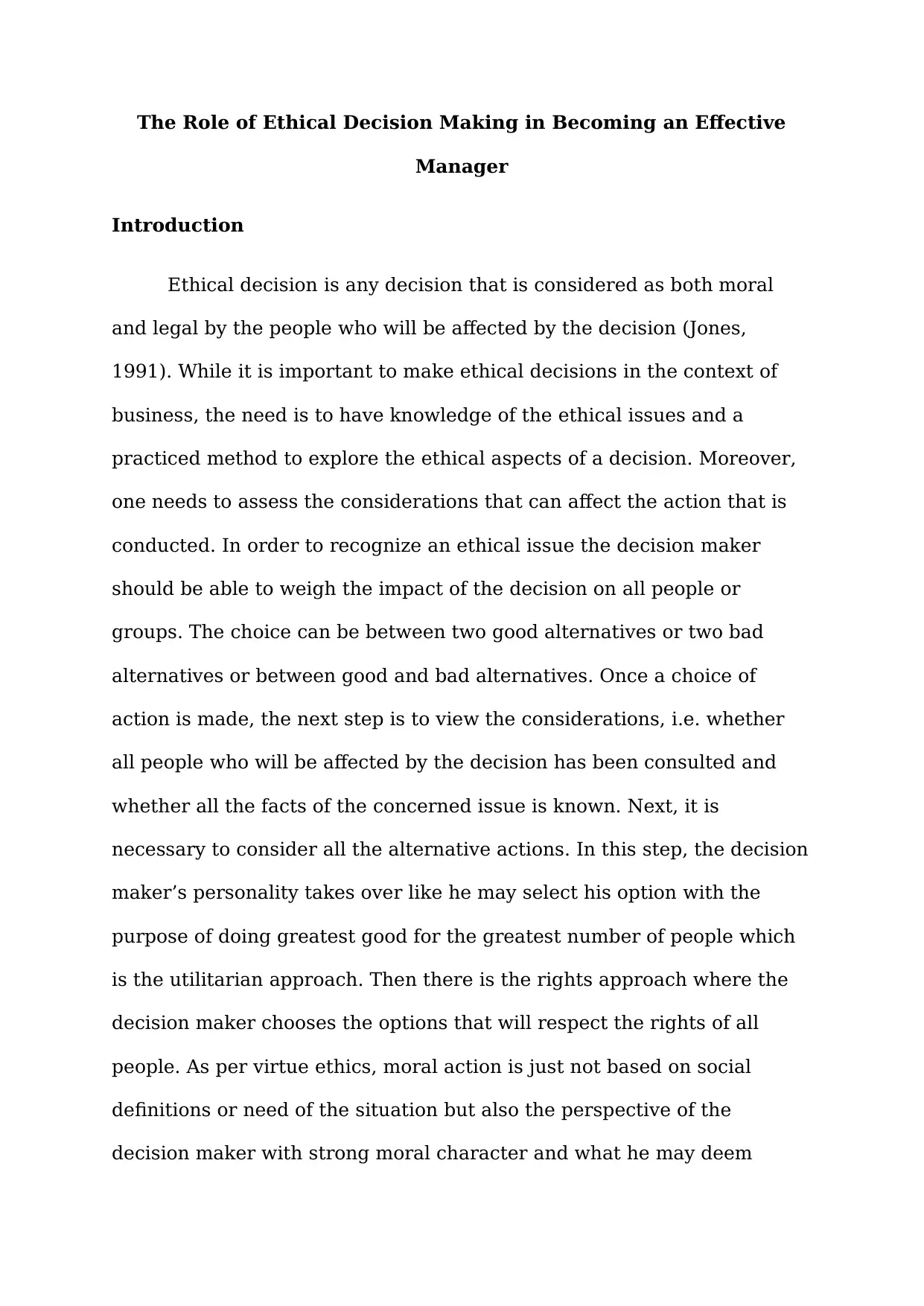
The Role of Ethical Decision Making in Becoming an Effective
Manager
Introduction
Ethical decision is any decision that is considered as both moral
and legal by the people who will be affected by the decision (Jones,
1991). While it is important to make ethical decisions in the context of
business, the need is to have knowledge of the ethical issues and a
practiced method to explore the ethical aspects of a decision. Moreover,
one needs to assess the considerations that can affect the action that is
conducted. In order to recognize an ethical issue the decision maker
should be able to weigh the impact of the decision on all people or
groups. The choice can be between two good alternatives or two bad
alternatives or between good and bad alternatives. Once a choice of
action is made, the next step is to view the considerations, i.e. whether
all people who will be affected by the decision has been consulted and
whether all the facts of the concerned issue is known. Next, it is
necessary to consider all the alternative actions. In this step, the decision
maker’s personality takes over like he may select his option with the
purpose of doing greatest good for the greatest number of people which
is the utilitarian approach. Then there is the rights approach where the
decision maker chooses the options that will respect the rights of all
people. As per virtue ethics, moral action is just not based on social
definitions or need of the situation but also the perspective of the
decision maker with strong moral character and what he may deem
Manager
Introduction
Ethical decision is any decision that is considered as both moral
and legal by the people who will be affected by the decision (Jones,
1991). While it is important to make ethical decisions in the context of
business, the need is to have knowledge of the ethical issues and a
practiced method to explore the ethical aspects of a decision. Moreover,
one needs to assess the considerations that can affect the action that is
conducted. In order to recognize an ethical issue the decision maker
should be able to weigh the impact of the decision on all people or
groups. The choice can be between two good alternatives or two bad
alternatives or between good and bad alternatives. Once a choice of
action is made, the next step is to view the considerations, i.e. whether
all people who will be affected by the decision has been consulted and
whether all the facts of the concerned issue is known. Next, it is
necessary to consider all the alternative actions. In this step, the decision
maker’s personality takes over like he may select his option with the
purpose of doing greatest good for the greatest number of people which
is the utilitarian approach. Then there is the rights approach where the
decision maker chooses the options that will respect the rights of all
people. As per virtue ethics, moral action is just not based on social
definitions or need of the situation but also the perspective of the
decision maker with strong moral character and what he may deem
Paraphrase This Document
Need a fresh take? Get an instant paraphrase of this document with our AI Paraphraser
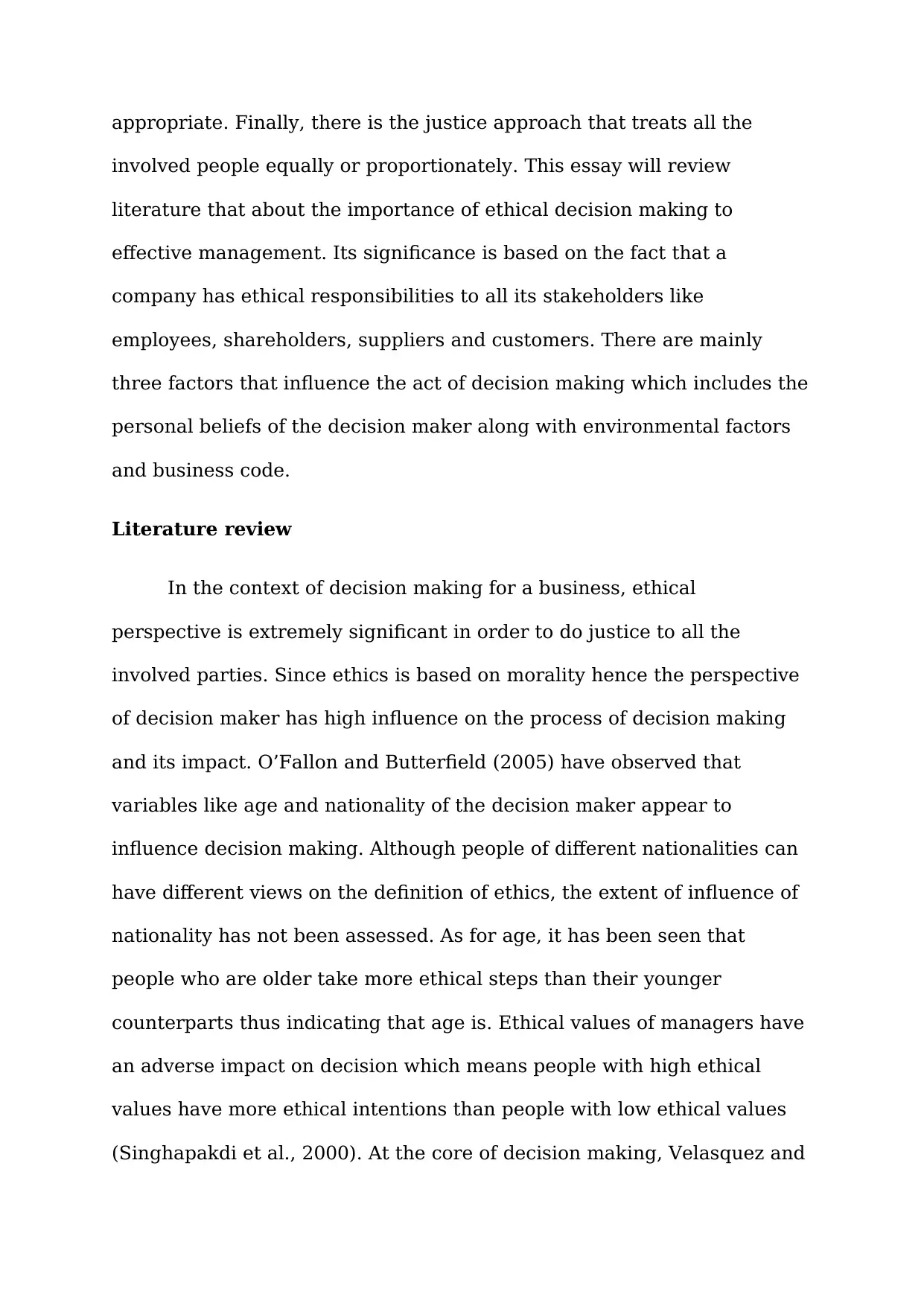
appropriate. Finally, there is the justice approach that treats all the
involved people equally or proportionately. This essay will review
literature that about the importance of ethical decision making to
effective management. Its significance is based on the fact that a
company has ethical responsibilities to all its stakeholders like
employees, shareholders, suppliers and customers. There are mainly
three factors that influence the act of decision making which includes the
personal beliefs of the decision maker along with environmental factors
and business code.
Literature review
In the context of decision making for a business, ethical
perspective is extremely significant in order to do justice to all the
involved parties. Since ethics is based on morality hence the perspective
of decision maker has high influence on the process of decision making
and its impact. O’Fallon and Butterfield (2005) have observed that
variables like age and nationality of the decision maker appear to
influence decision making. Although people of different nationalities can
have different views on the definition of ethics, the extent of influence of
nationality has not been assessed. As for age, it has been seen that
people who are older take more ethical steps than their younger
counterparts thus indicating that age is. Ethical values of managers have
an adverse impact on decision which means people with high ethical
values have more ethical intentions than people with low ethical values
(Singhapakdi et al., 2000). At the core of decision making, Velasquez and
involved people equally or proportionately. This essay will review
literature that about the importance of ethical decision making to
effective management. Its significance is based on the fact that a
company has ethical responsibilities to all its stakeholders like
employees, shareholders, suppliers and customers. There are mainly
three factors that influence the act of decision making which includes the
personal beliefs of the decision maker along with environmental factors
and business code.
Literature review
In the context of decision making for a business, ethical
perspective is extremely significant in order to do justice to all the
involved parties. Since ethics is based on morality hence the perspective
of decision maker has high influence on the process of decision making
and its impact. O’Fallon and Butterfield (2005) have observed that
variables like age and nationality of the decision maker appear to
influence decision making. Although people of different nationalities can
have different views on the definition of ethics, the extent of influence of
nationality has not been assessed. As for age, it has been seen that
people who are older take more ethical steps than their younger
counterparts thus indicating that age is. Ethical values of managers have
an adverse impact on decision which means people with high ethical
values have more ethical intentions than people with low ethical values
(Singhapakdi et al., 2000). At the core of decision making, Velasquez and
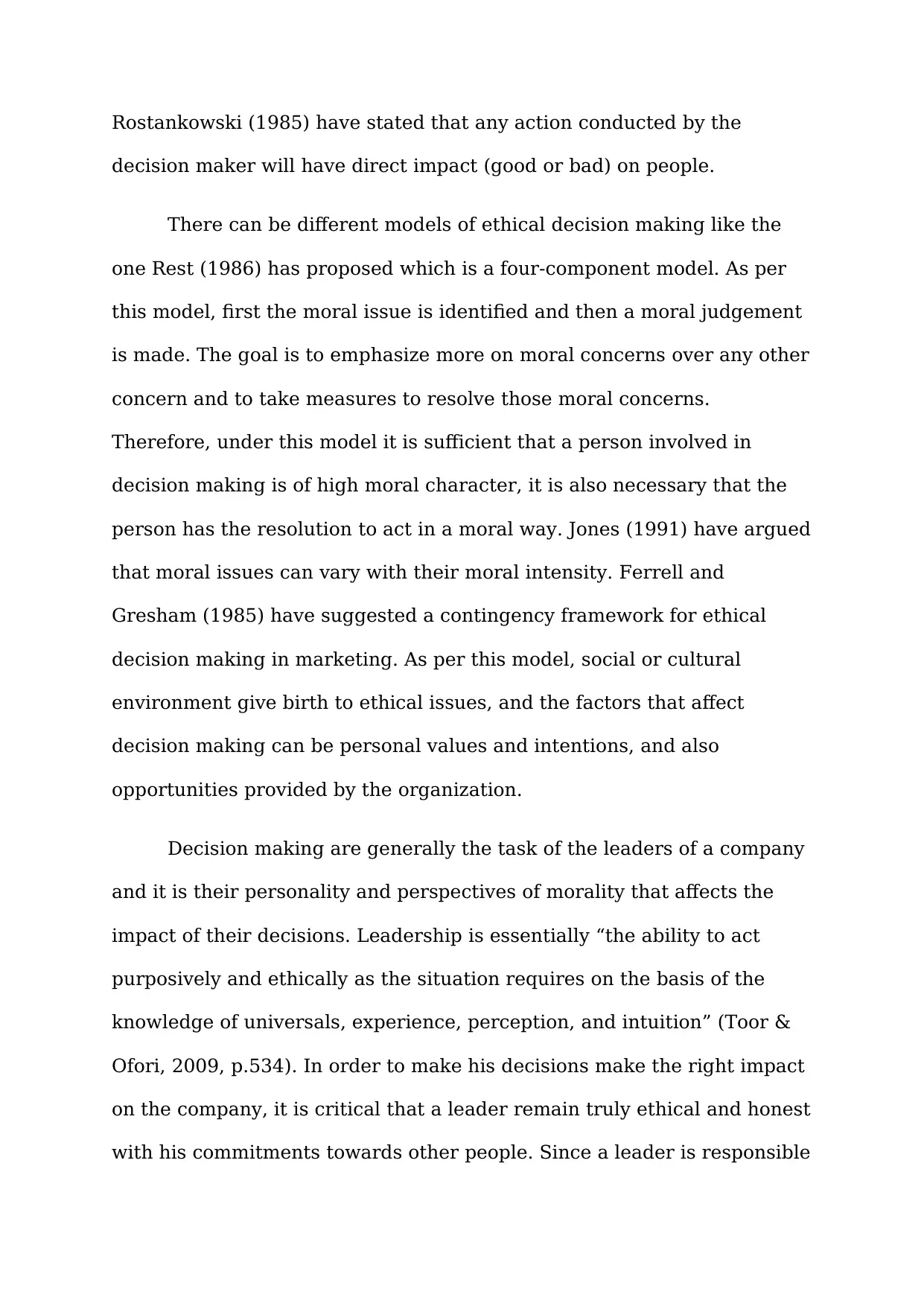
Rostankowski (1985) have stated that any action conducted by the
decision maker will have direct impact (good or bad) on people.
There can be different models of ethical decision making like the
one Rest (1986) has proposed which is a four-component model. As per
this model, first the moral issue is identified and then a moral judgement
is made. The goal is to emphasize more on moral concerns over any other
concern and to take measures to resolve those moral concerns.
Therefore, under this model it is sufficient that a person involved in
decision making is of high moral character, it is also necessary that the
person has the resolution to act in a moral way. Jones (1991) have argued
that moral issues can vary with their moral intensity. Ferrell and
Gresham (1985) have suggested a contingency framework for ethical
decision making in marketing. As per this model, social or cultural
environment give birth to ethical issues, and the factors that affect
decision making can be personal values and intentions, and also
opportunities provided by the organization.
Decision making are generally the task of the leaders of a company
and it is their personality and perspectives of morality that affects the
impact of their decisions. Leadership is essentially “the ability to act
purposively and ethically as the situation requires on the basis of the
knowledge of universals, experience, perception, and intuition” (Toor &
Ofori, 2009, p.534). In order to make his decisions make the right impact
on the company, it is critical that a leader remain truly ethical and honest
with his commitments towards other people. Since a leader is responsible
decision maker will have direct impact (good or bad) on people.
There can be different models of ethical decision making like the
one Rest (1986) has proposed which is a four-component model. As per
this model, first the moral issue is identified and then a moral judgement
is made. The goal is to emphasize more on moral concerns over any other
concern and to take measures to resolve those moral concerns.
Therefore, under this model it is sufficient that a person involved in
decision making is of high moral character, it is also necessary that the
person has the resolution to act in a moral way. Jones (1991) have argued
that moral issues can vary with their moral intensity. Ferrell and
Gresham (1985) have suggested a contingency framework for ethical
decision making in marketing. As per this model, social or cultural
environment give birth to ethical issues, and the factors that affect
decision making can be personal values and intentions, and also
opportunities provided by the organization.
Decision making are generally the task of the leaders of a company
and it is their personality and perspectives of morality that affects the
impact of their decisions. Leadership is essentially “the ability to act
purposively and ethically as the situation requires on the basis of the
knowledge of universals, experience, perception, and intuition” (Toor &
Ofori, 2009, p.534). In order to make his decisions make the right impact
on the company, it is critical that a leader remain truly ethical and honest
with his commitments towards other people. Since a leader is responsible
⊘ This is a preview!⊘
Do you want full access?
Subscribe today to unlock all pages.

Trusted by 1+ million students worldwide
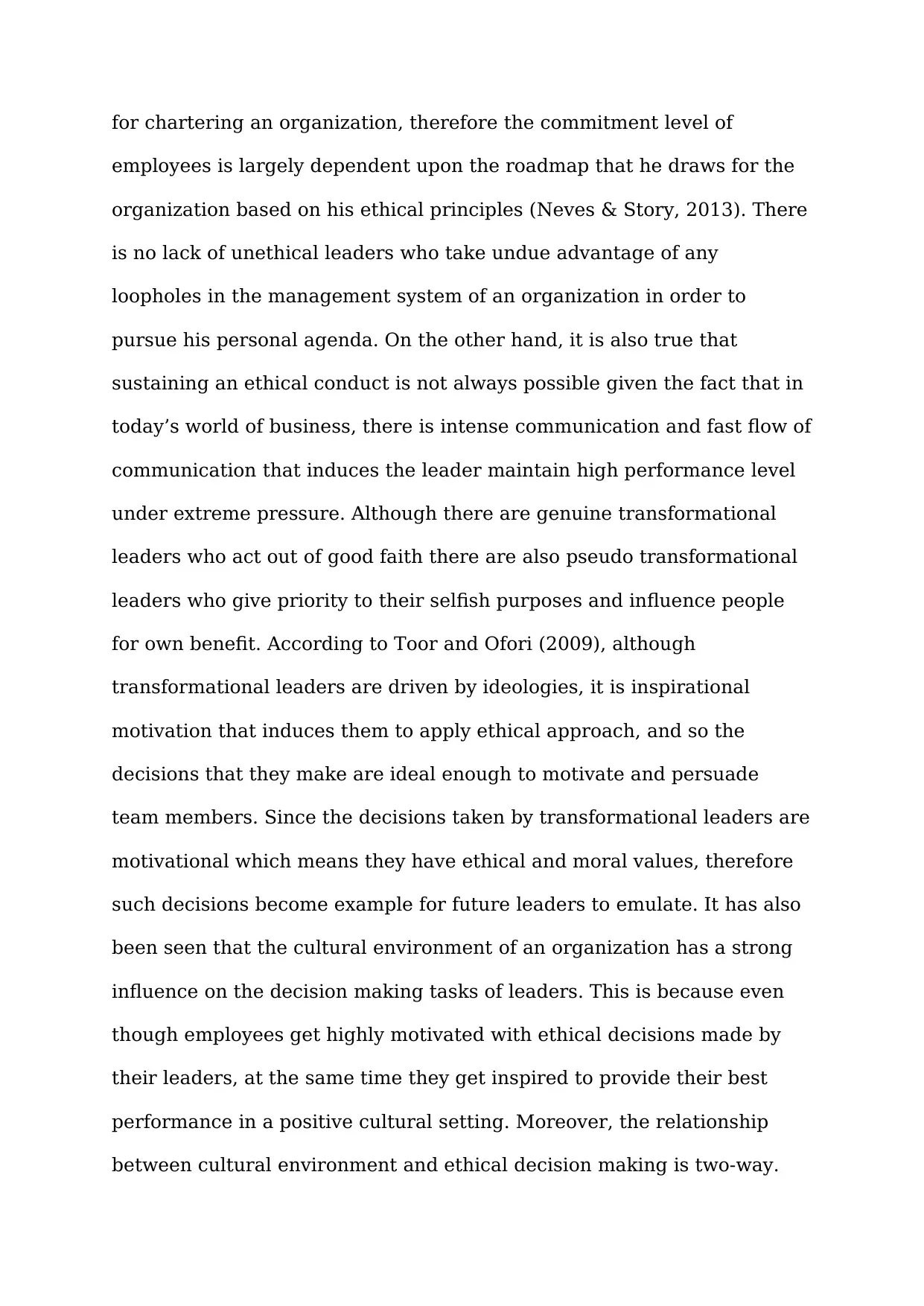
for chartering an organization, therefore the commitment level of
employees is largely dependent upon the roadmap that he draws for the
organization based on his ethical principles (Neves & Story, 2013). There
is no lack of unethical leaders who take undue advantage of any
loopholes in the management system of an organization in order to
pursue his personal agenda. On the other hand, it is also true that
sustaining an ethical conduct is not always possible given the fact that in
today’s world of business, there is intense communication and fast flow of
communication that induces the leader maintain high performance level
under extreme pressure. Although there are genuine transformational
leaders who act out of good faith there are also pseudo transformational
leaders who give priority to their selfish purposes and influence people
for own benefit. According to Toor and Ofori (2009), although
transformational leaders are driven by ideologies, it is inspirational
motivation that induces them to apply ethical approach, and so the
decisions that they make are ideal enough to motivate and persuade
team members. Since the decisions taken by transformational leaders are
motivational which means they have ethical and moral values, therefore
such decisions become example for future leaders to emulate. It has also
been seen that the cultural environment of an organization has a strong
influence on the decision making tasks of leaders. This is because even
though employees get highly motivated with ethical decisions made by
their leaders, at the same time they get inspired to provide their best
performance in a positive cultural setting. Moreover, the relationship
between cultural environment and ethical decision making is two-way.
employees is largely dependent upon the roadmap that he draws for the
organization based on his ethical principles (Neves & Story, 2013). There
is no lack of unethical leaders who take undue advantage of any
loopholes in the management system of an organization in order to
pursue his personal agenda. On the other hand, it is also true that
sustaining an ethical conduct is not always possible given the fact that in
today’s world of business, there is intense communication and fast flow of
communication that induces the leader maintain high performance level
under extreme pressure. Although there are genuine transformational
leaders who act out of good faith there are also pseudo transformational
leaders who give priority to their selfish purposes and influence people
for own benefit. According to Toor and Ofori (2009), although
transformational leaders are driven by ideologies, it is inspirational
motivation that induces them to apply ethical approach, and so the
decisions that they make are ideal enough to motivate and persuade
team members. Since the decisions taken by transformational leaders are
motivational which means they have ethical and moral values, therefore
such decisions become example for future leaders to emulate. It has also
been seen that the cultural environment of an organization has a strong
influence on the decision making tasks of leaders. This is because even
though employees get highly motivated with ethical decisions made by
their leaders, at the same time they get inspired to provide their best
performance in a positive cultural setting. Moreover, the relationship
between cultural environment and ethical decision making is two-way.
Paraphrase This Document
Need a fresh take? Get an instant paraphrase of this document with our AI Paraphraser
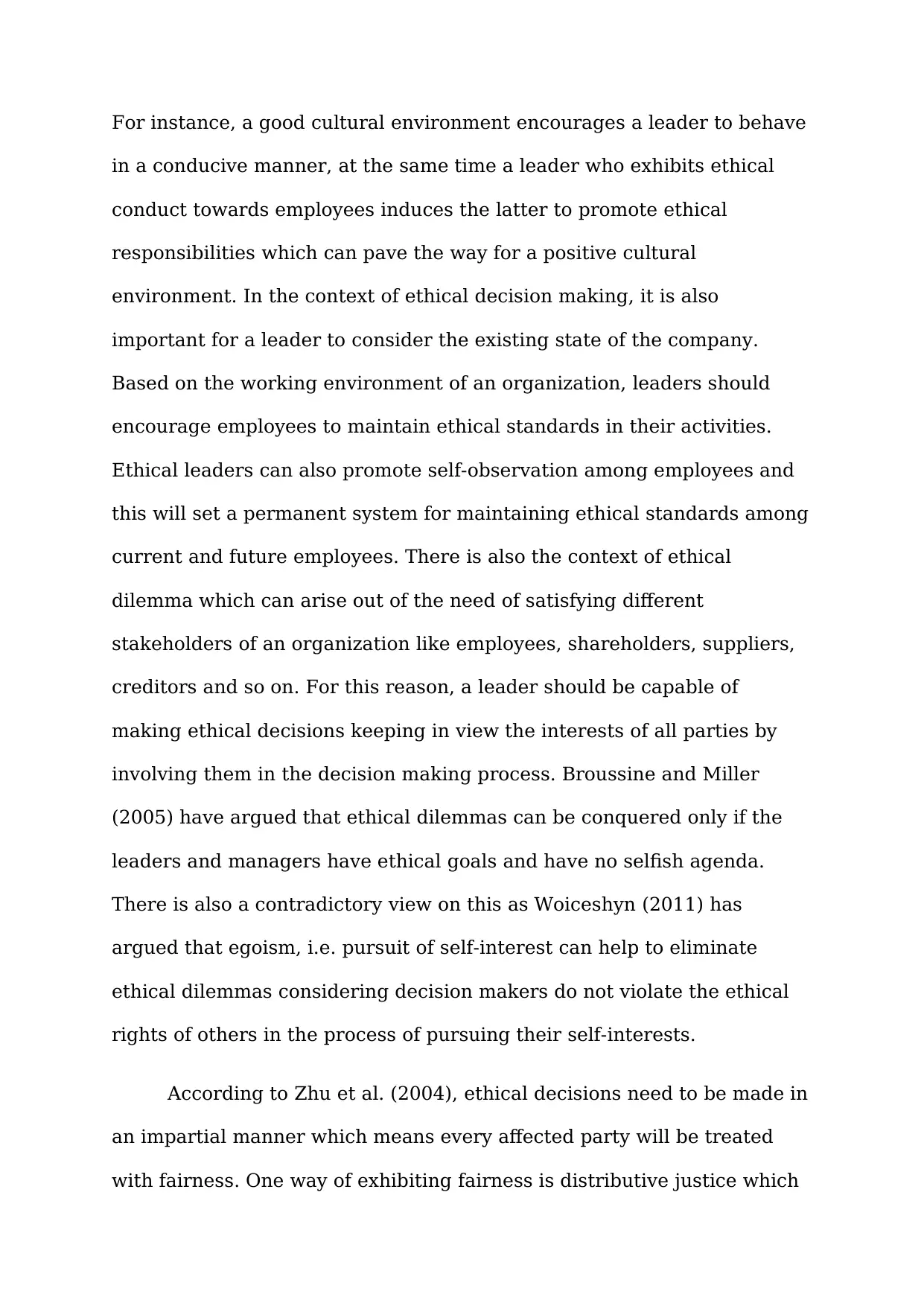
For instance, a good cultural environment encourages a leader to behave
in a conducive manner, at the same time a leader who exhibits ethical
conduct towards employees induces the latter to promote ethical
responsibilities which can pave the way for a positive cultural
environment. In the context of ethical decision making, it is also
important for a leader to consider the existing state of the company.
Based on the working environment of an organization, leaders should
encourage employees to maintain ethical standards in their activities.
Ethical leaders can also promote self-observation among employees and
this will set a permanent system for maintaining ethical standards among
current and future employees. There is also the context of ethical
dilemma which can arise out of the need of satisfying different
stakeholders of an organization like employees, shareholders, suppliers,
creditors and so on. For this reason, a leader should be capable of
making ethical decisions keeping in view the interests of all parties by
involving them in the decision making process. Broussine and Miller
(2005) have argued that ethical dilemmas can be conquered only if the
leaders and managers have ethical goals and have no selfish agenda.
There is also a contradictory view on this as Woiceshyn (2011) has
argued that egoism, i.e. pursuit of self-interest can help to eliminate
ethical dilemmas considering decision makers do not violate the ethical
rights of others in the process of pursuing their self-interests.
According to Zhu et al. (2004), ethical decisions need to be made in
an impartial manner which means every affected party will be treated
with fairness. One way of exhibiting fairness is distributive justice which
in a conducive manner, at the same time a leader who exhibits ethical
conduct towards employees induces the latter to promote ethical
responsibilities which can pave the way for a positive cultural
environment. In the context of ethical decision making, it is also
important for a leader to consider the existing state of the company.
Based on the working environment of an organization, leaders should
encourage employees to maintain ethical standards in their activities.
Ethical leaders can also promote self-observation among employees and
this will set a permanent system for maintaining ethical standards among
current and future employees. There is also the context of ethical
dilemma which can arise out of the need of satisfying different
stakeholders of an organization like employees, shareholders, suppliers,
creditors and so on. For this reason, a leader should be capable of
making ethical decisions keeping in view the interests of all parties by
involving them in the decision making process. Broussine and Miller
(2005) have argued that ethical dilemmas can be conquered only if the
leaders and managers have ethical goals and have no selfish agenda.
There is also a contradictory view on this as Woiceshyn (2011) has
argued that egoism, i.e. pursuit of self-interest can help to eliminate
ethical dilemmas considering decision makers do not violate the ethical
rights of others in the process of pursuing their self-interests.
According to Zhu et al. (2004), ethical decisions need to be made in
an impartial manner which means every affected party will be treated
with fairness. One way of exhibiting fairness is distributive justice which
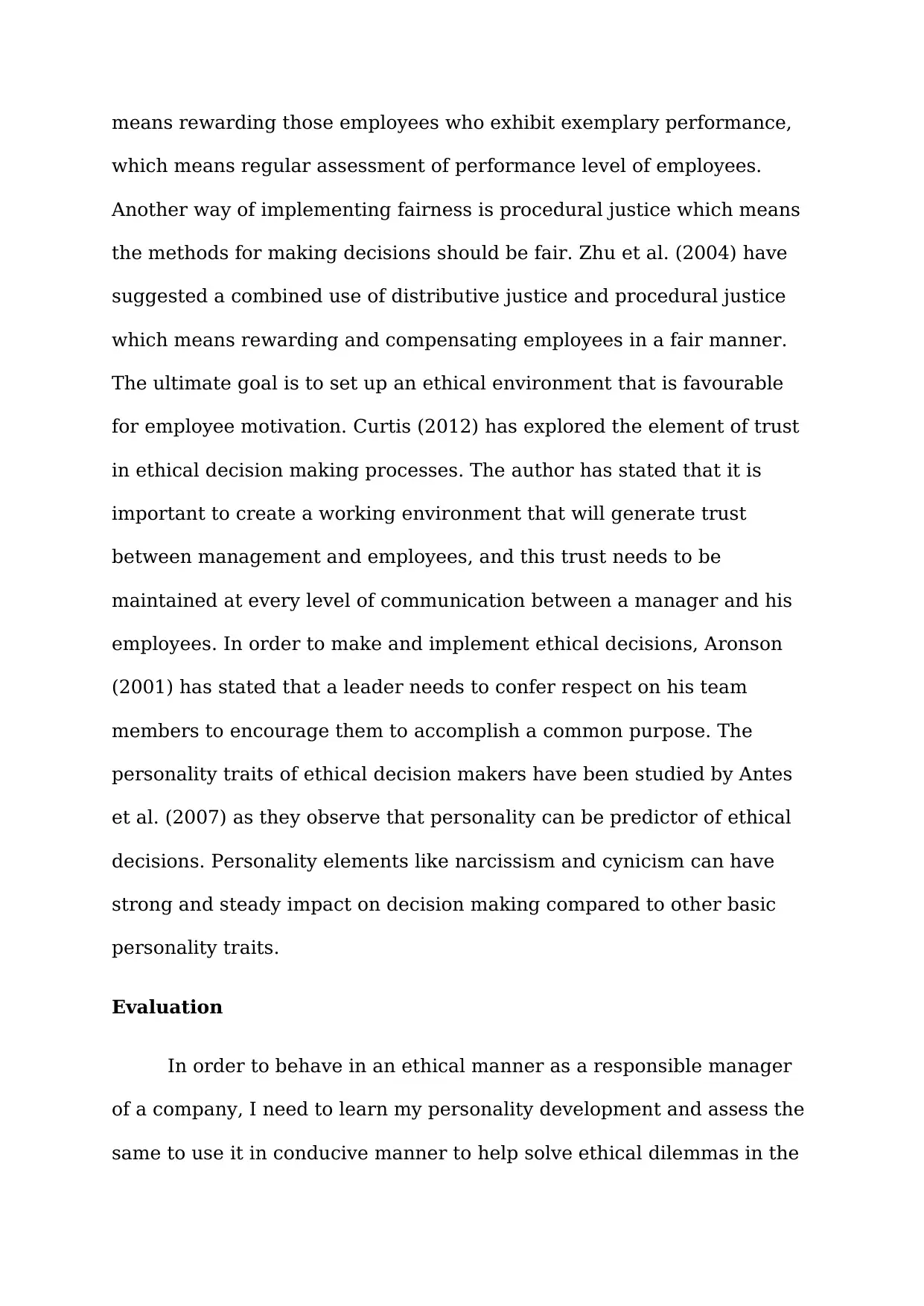
means rewarding those employees who exhibit exemplary performance,
which means regular assessment of performance level of employees.
Another way of implementing fairness is procedural justice which means
the methods for making decisions should be fair. Zhu et al. (2004) have
suggested a combined use of distributive justice and procedural justice
which means rewarding and compensating employees in a fair manner.
The ultimate goal is to set up an ethical environment that is favourable
for employee motivation. Curtis (2012) has explored the element of trust
in ethical decision making processes. The author has stated that it is
important to create a working environment that will generate trust
between management and employees, and this trust needs to be
maintained at every level of communication between a manager and his
employees. In order to make and implement ethical decisions, Aronson
(2001) has stated that a leader needs to confer respect on his team
members to encourage them to accomplish a common purpose. The
personality traits of ethical decision makers have been studied by Antes
et al. (2007) as they observe that personality can be predictor of ethical
decisions. Personality elements like narcissism and cynicism can have
strong and steady impact on decision making compared to other basic
personality traits.
Evaluation
In order to behave in an ethical manner as a responsible manager
of a company, I need to learn my personality development and assess the
same to use it in conducive manner to help solve ethical dilemmas in the
which means regular assessment of performance level of employees.
Another way of implementing fairness is procedural justice which means
the methods for making decisions should be fair. Zhu et al. (2004) have
suggested a combined use of distributive justice and procedural justice
which means rewarding and compensating employees in a fair manner.
The ultimate goal is to set up an ethical environment that is favourable
for employee motivation. Curtis (2012) has explored the element of trust
in ethical decision making processes. The author has stated that it is
important to create a working environment that will generate trust
between management and employees, and this trust needs to be
maintained at every level of communication between a manager and his
employees. In order to make and implement ethical decisions, Aronson
(2001) has stated that a leader needs to confer respect on his team
members to encourage them to accomplish a common purpose. The
personality traits of ethical decision makers have been studied by Antes
et al. (2007) as they observe that personality can be predictor of ethical
decisions. Personality elements like narcissism and cynicism can have
strong and steady impact on decision making compared to other basic
personality traits.
Evaluation
In order to behave in an ethical manner as a responsible manager
of a company, I need to learn my personality development and assess the
same to use it in conducive manner to help solve ethical dilemmas in the
⊘ This is a preview!⊘
Do you want full access?
Subscribe today to unlock all pages.

Trusted by 1+ million students worldwide
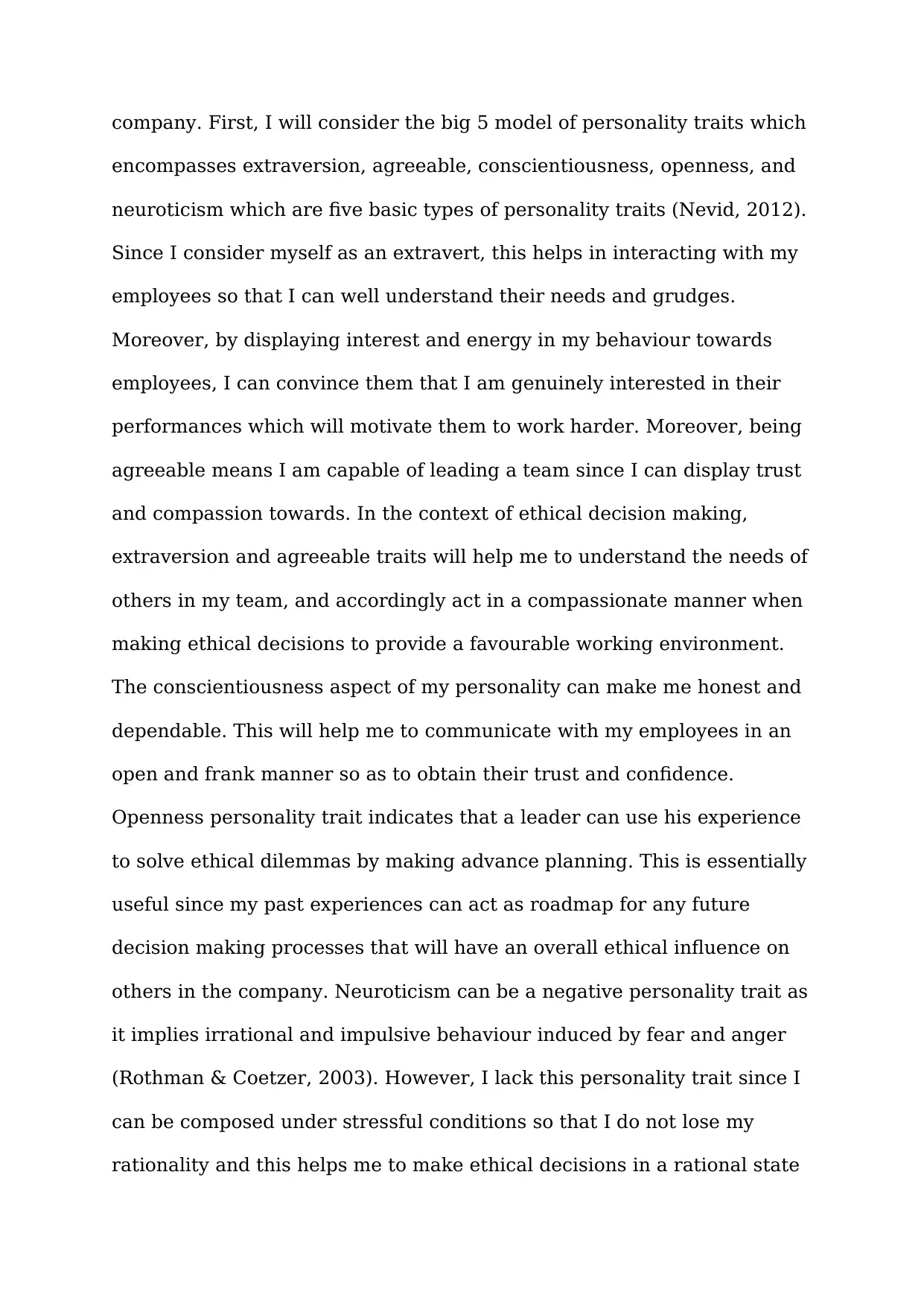
company. First, I will consider the big 5 model of personality traits which
encompasses extraversion, agreeable, conscientiousness, openness, and
neuroticism which are five basic types of personality traits (Nevid, 2012).
Since I consider myself as an extravert, this helps in interacting with my
employees so that I can well understand their needs and grudges.
Moreover, by displaying interest and energy in my behaviour towards
employees, I can convince them that I am genuinely interested in their
performances which will motivate them to work harder. Moreover, being
agreeable means I am capable of leading a team since I can display trust
and compassion towards. In the context of ethical decision making,
extraversion and agreeable traits will help me to understand the needs of
others in my team, and accordingly act in a compassionate manner when
making ethical decisions to provide a favourable working environment.
The conscientiousness aspect of my personality can make me honest and
dependable. This will help me to communicate with my employees in an
open and frank manner so as to obtain their trust and confidence.
Openness personality trait indicates that a leader can use his experience
to solve ethical dilemmas by making advance planning. This is essentially
useful since my past experiences can act as roadmap for any future
decision making processes that will have an overall ethical influence on
others in the company. Neuroticism can be a negative personality trait as
it implies irrational and impulsive behaviour induced by fear and anger
(Rothman & Coetzer, 2003). However, I lack this personality trait since I
can be composed under stressful conditions so that I do not lose my
rationality and this helps me to make ethical decisions in a rational state
encompasses extraversion, agreeable, conscientiousness, openness, and
neuroticism which are five basic types of personality traits (Nevid, 2012).
Since I consider myself as an extravert, this helps in interacting with my
employees so that I can well understand their needs and grudges.
Moreover, by displaying interest and energy in my behaviour towards
employees, I can convince them that I am genuinely interested in their
performances which will motivate them to work harder. Moreover, being
agreeable means I am capable of leading a team since I can display trust
and compassion towards. In the context of ethical decision making,
extraversion and agreeable traits will help me to understand the needs of
others in my team, and accordingly act in a compassionate manner when
making ethical decisions to provide a favourable working environment.
The conscientiousness aspect of my personality can make me honest and
dependable. This will help me to communicate with my employees in an
open and frank manner so as to obtain their trust and confidence.
Openness personality trait indicates that a leader can use his experience
to solve ethical dilemmas by making advance planning. This is essentially
useful since my past experiences can act as roadmap for any future
decision making processes that will have an overall ethical influence on
others in the company. Neuroticism can be a negative personality trait as
it implies irrational and impulsive behaviour induced by fear and anger
(Rothman & Coetzer, 2003). However, I lack this personality trait since I
can be composed under stressful conditions so that I do not lose my
rationality and this helps me to make ethical decisions in a rational state
Paraphrase This Document
Need a fresh take? Get an instant paraphrase of this document with our AI Paraphraser
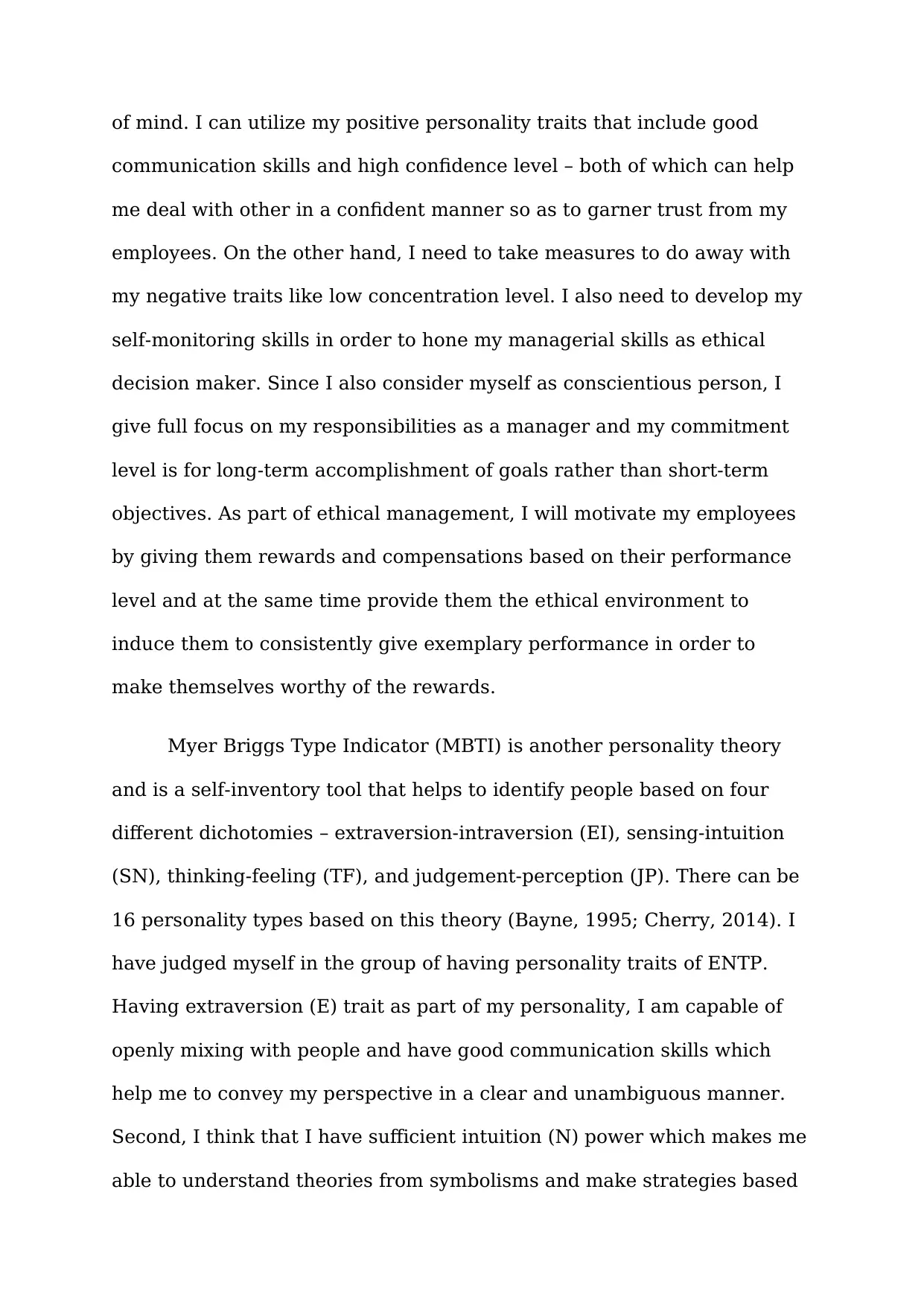
of mind. I can utilize my positive personality traits that include good
communication skills and high confidence level – both of which can help
me deal with other in a confident manner so as to garner trust from my
employees. On the other hand, I need to take measures to do away with
my negative traits like low concentration level. I also need to develop my
self-monitoring skills in order to hone my managerial skills as ethical
decision maker. Since I also consider myself as conscientious person, I
give full focus on my responsibilities as a manager and my commitment
level is for long-term accomplishment of goals rather than short-term
objectives. As part of ethical management, I will motivate my employees
by giving them rewards and compensations based on their performance
level and at the same time provide them the ethical environment to
induce them to consistently give exemplary performance in order to
make themselves worthy of the rewards.
Myer Briggs Type Indicator (MBTI) is another personality theory
and is a self-inventory tool that helps to identify people based on four
different dichotomies – extraversion-intraversion (EI), sensing-intuition
(SN), thinking-feeling (TF), and judgement-perception (JP). There can be
16 personality types based on this theory (Bayne, 1995; Cherry, 2014). I
have judged myself in the group of having personality traits of ENTP.
Having extraversion (E) trait as part of my personality, I am capable of
openly mixing with people and have good communication skills which
help me to convey my perspective in a clear and unambiguous manner.
Second, I think that I have sufficient intuition (N) power which makes me
able to understand theories from symbolisms and make strategies based
communication skills and high confidence level – both of which can help
me deal with other in a confident manner so as to garner trust from my
employees. On the other hand, I need to take measures to do away with
my negative traits like low concentration level. I also need to develop my
self-monitoring skills in order to hone my managerial skills as ethical
decision maker. Since I also consider myself as conscientious person, I
give full focus on my responsibilities as a manager and my commitment
level is for long-term accomplishment of goals rather than short-term
objectives. As part of ethical management, I will motivate my employees
by giving them rewards and compensations based on their performance
level and at the same time provide them the ethical environment to
induce them to consistently give exemplary performance in order to
make themselves worthy of the rewards.
Myer Briggs Type Indicator (MBTI) is another personality theory
and is a self-inventory tool that helps to identify people based on four
different dichotomies – extraversion-intraversion (EI), sensing-intuition
(SN), thinking-feeling (TF), and judgement-perception (JP). There can be
16 personality types based on this theory (Bayne, 1995; Cherry, 2014). I
have judged myself in the group of having personality traits of ENTP.
Having extraversion (E) trait as part of my personality, I am capable of
openly mixing with people and have good communication skills which
help me to convey my perspective in a clear and unambiguous manner.
Second, I think that I have sufficient intuition (N) power which makes me
able to understand theories from symbolisms and make strategies based
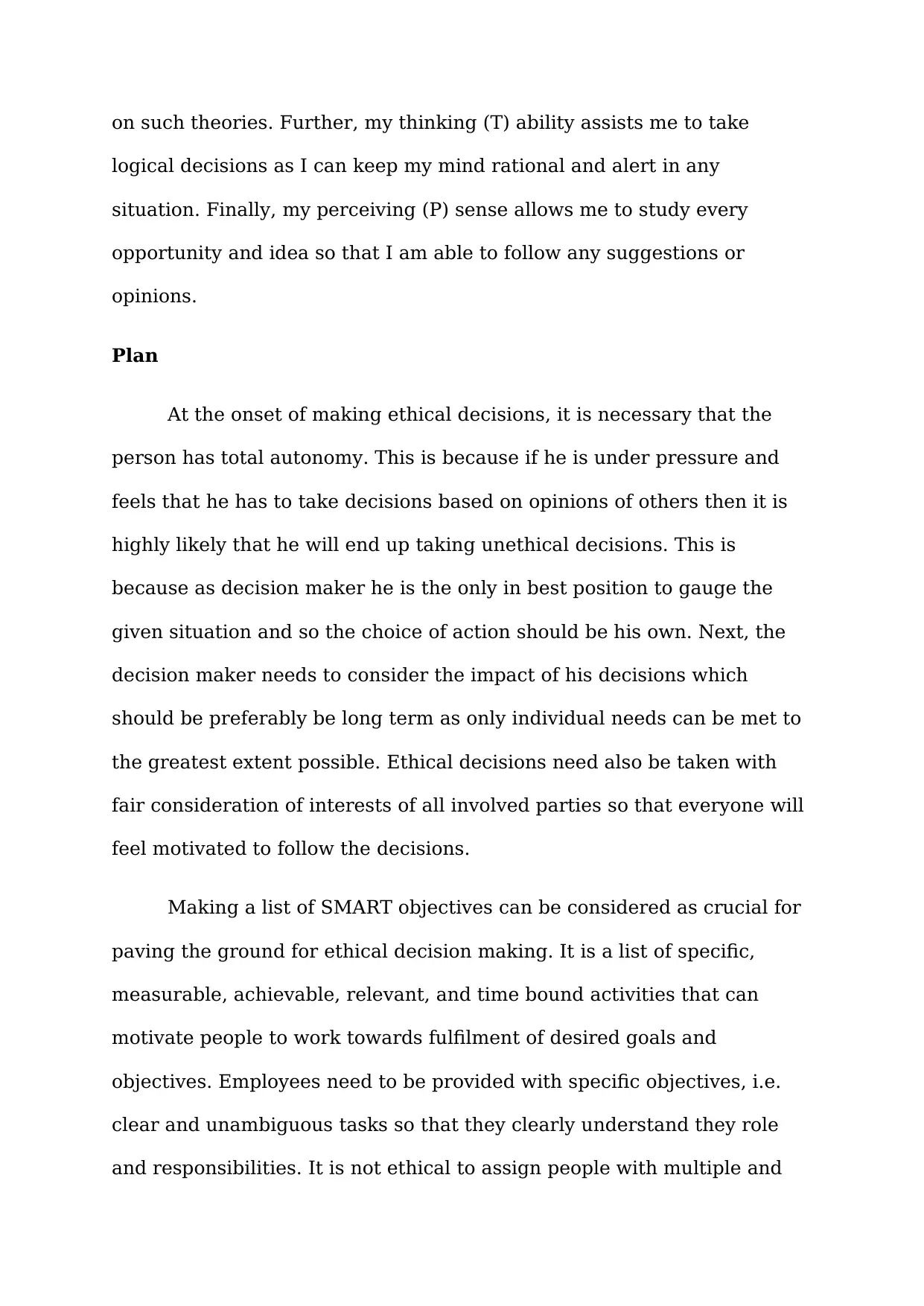
on such theories. Further, my thinking (T) ability assists me to take
logical decisions as I can keep my mind rational and alert in any
situation. Finally, my perceiving (P) sense allows me to study every
opportunity and idea so that I am able to follow any suggestions or
opinions.
Plan
At the onset of making ethical decisions, it is necessary that the
person has total autonomy. This is because if he is under pressure and
feels that he has to take decisions based on opinions of others then it is
highly likely that he will end up taking unethical decisions. This is
because as decision maker he is the only in best position to gauge the
given situation and so the choice of action should be his own. Next, the
decision maker needs to consider the impact of his decisions which
should be preferably be long term as only individual needs can be met to
the greatest extent possible. Ethical decisions need also be taken with
fair consideration of interests of all involved parties so that everyone will
feel motivated to follow the decisions.
Making a list of SMART objectives can be considered as crucial for
paving the ground for ethical decision making. It is a list of specific,
measurable, achievable, relevant, and time bound activities that can
motivate people to work towards fulfilment of desired goals and
objectives. Employees need to be provided with specific objectives, i.e.
clear and unambiguous tasks so that they clearly understand they role
and responsibilities. It is not ethical to assign people with multiple and
logical decisions as I can keep my mind rational and alert in any
situation. Finally, my perceiving (P) sense allows me to study every
opportunity and idea so that I am able to follow any suggestions or
opinions.
Plan
At the onset of making ethical decisions, it is necessary that the
person has total autonomy. This is because if he is under pressure and
feels that he has to take decisions based on opinions of others then it is
highly likely that he will end up taking unethical decisions. This is
because as decision maker he is the only in best position to gauge the
given situation and so the choice of action should be his own. Next, the
decision maker needs to consider the impact of his decisions which
should be preferably be long term as only individual needs can be met to
the greatest extent possible. Ethical decisions need also be taken with
fair consideration of interests of all involved parties so that everyone will
feel motivated to follow the decisions.
Making a list of SMART objectives can be considered as crucial for
paving the ground for ethical decision making. It is a list of specific,
measurable, achievable, relevant, and time bound activities that can
motivate people to work towards fulfilment of desired goals and
objectives. Employees need to be provided with specific objectives, i.e.
clear and unambiguous tasks so that they clearly understand they role
and responsibilities. It is not ethical to assign people with multiple and
⊘ This is a preview!⊘
Do you want full access?
Subscribe today to unlock all pages.

Trusted by 1+ million students worldwide
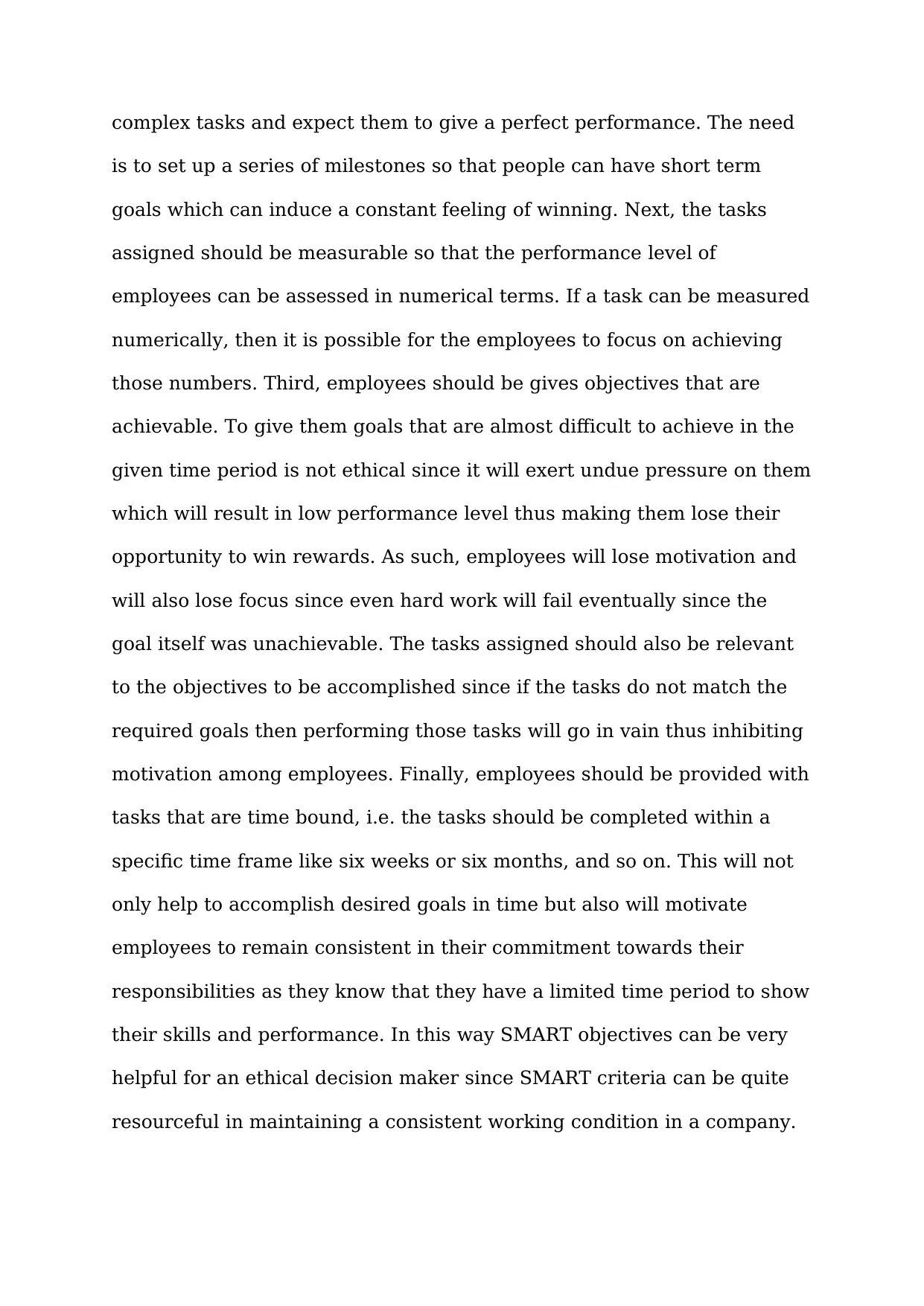
complex tasks and expect them to give a perfect performance. The need
is to set up a series of milestones so that people can have short term
goals which can induce a constant feeling of winning. Next, the tasks
assigned should be measurable so that the performance level of
employees can be assessed in numerical terms. If a task can be measured
numerically, then it is possible for the employees to focus on achieving
those numbers. Third, employees should be gives objectives that are
achievable. To give them goals that are almost difficult to achieve in the
given time period is not ethical since it will exert undue pressure on them
which will result in low performance level thus making them lose their
opportunity to win rewards. As such, employees will lose motivation and
will also lose focus since even hard work will fail eventually since the
goal itself was unachievable. The tasks assigned should also be relevant
to the objectives to be accomplished since if the tasks do not match the
required goals then performing those tasks will go in vain thus inhibiting
motivation among employees. Finally, employees should be provided with
tasks that are time bound, i.e. the tasks should be completed within a
specific time frame like six weeks or six months, and so on. This will not
only help to accomplish desired goals in time but also will motivate
employees to remain consistent in their commitment towards their
responsibilities as they know that they have a limited time period to show
their skills and performance. In this way SMART objectives can be very
helpful for an ethical decision maker since SMART criteria can be quite
resourceful in maintaining a consistent working condition in a company.
is to set up a series of milestones so that people can have short term
goals which can induce a constant feeling of winning. Next, the tasks
assigned should be measurable so that the performance level of
employees can be assessed in numerical terms. If a task can be measured
numerically, then it is possible for the employees to focus on achieving
those numbers. Third, employees should be gives objectives that are
achievable. To give them goals that are almost difficult to achieve in the
given time period is not ethical since it will exert undue pressure on them
which will result in low performance level thus making them lose their
opportunity to win rewards. As such, employees will lose motivation and
will also lose focus since even hard work will fail eventually since the
goal itself was unachievable. The tasks assigned should also be relevant
to the objectives to be accomplished since if the tasks do not match the
required goals then performing those tasks will go in vain thus inhibiting
motivation among employees. Finally, employees should be provided with
tasks that are time bound, i.e. the tasks should be completed within a
specific time frame like six weeks or six months, and so on. This will not
only help to accomplish desired goals in time but also will motivate
employees to remain consistent in their commitment towards their
responsibilities as they know that they have a limited time period to show
their skills and performance. In this way SMART objectives can be very
helpful for an ethical decision maker since SMART criteria can be quite
resourceful in maintaining a consistent working condition in a company.
Paraphrase This Document
Need a fresh take? Get an instant paraphrase of this document with our AI Paraphraser
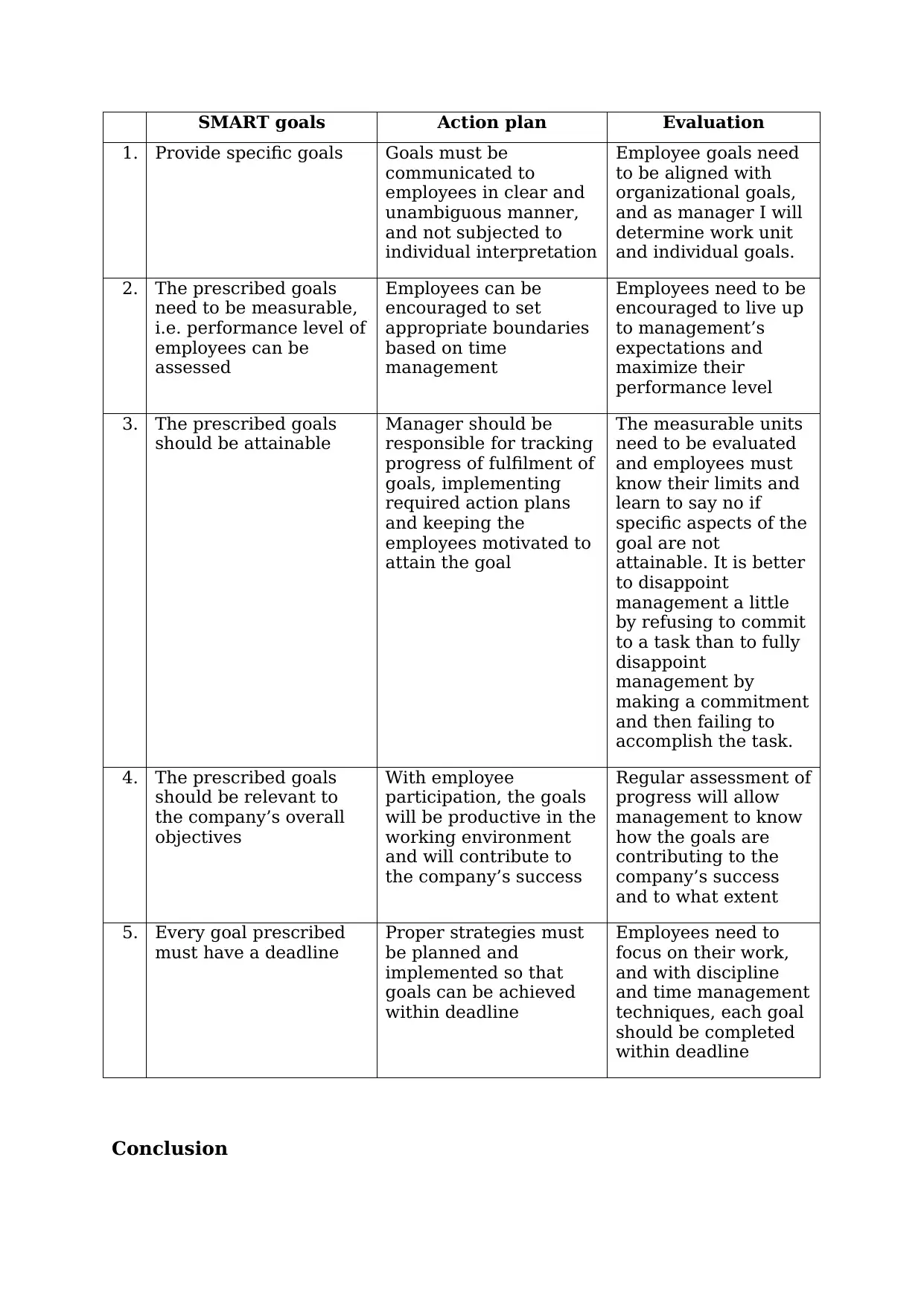
SMART goals Action plan Evaluation
1. Provide specific goals Goals must be
communicated to
employees in clear and
unambiguous manner,
and not subjected to
individual interpretation
Employee goals need
to be aligned with
organizational goals,
and as manager I will
determine work unit
and individual goals.
2. The prescribed goals
need to be measurable,
i.e. performance level of
employees can be
assessed
Employees can be
encouraged to set
appropriate boundaries
based on time
management
Employees need to be
encouraged to live up
to management’s
expectations and
maximize their
performance level
3. The prescribed goals
should be attainable
Manager should be
responsible for tracking
progress of fulfilment of
goals, implementing
required action plans
and keeping the
employees motivated to
attain the goal
The measurable units
need to be evaluated
and employees must
know their limits and
learn to say no if
specific aspects of the
goal are not
attainable. It is better
to disappoint
management a little
by refusing to commit
to a task than to fully
disappoint
management by
making a commitment
and then failing to
accomplish the task.
4. The prescribed goals
should be relevant to
the company’s overall
objectives
With employee
participation, the goals
will be productive in the
working environment
and will contribute to
the company’s success
Regular assessment of
progress will allow
management to know
how the goals are
contributing to the
company’s success
and to what extent
5. Every goal prescribed
must have a deadline
Proper strategies must
be planned and
implemented so that
goals can be achieved
within deadline
Employees need to
focus on their work,
and with discipline
and time management
techniques, each goal
should be completed
within deadline
Conclusion
1. Provide specific goals Goals must be
communicated to
employees in clear and
unambiguous manner,
and not subjected to
individual interpretation
Employee goals need
to be aligned with
organizational goals,
and as manager I will
determine work unit
and individual goals.
2. The prescribed goals
need to be measurable,
i.e. performance level of
employees can be
assessed
Employees can be
encouraged to set
appropriate boundaries
based on time
management
Employees need to be
encouraged to live up
to management’s
expectations and
maximize their
performance level
3. The prescribed goals
should be attainable
Manager should be
responsible for tracking
progress of fulfilment of
goals, implementing
required action plans
and keeping the
employees motivated to
attain the goal
The measurable units
need to be evaluated
and employees must
know their limits and
learn to say no if
specific aspects of the
goal are not
attainable. It is better
to disappoint
management a little
by refusing to commit
to a task than to fully
disappoint
management by
making a commitment
and then failing to
accomplish the task.
4. The prescribed goals
should be relevant to
the company’s overall
objectives
With employee
participation, the goals
will be productive in the
working environment
and will contribute to
the company’s success
Regular assessment of
progress will allow
management to know
how the goals are
contributing to the
company’s success
and to what extent
5. Every goal prescribed
must have a deadline
Proper strategies must
be planned and
implemented so that
goals can be achieved
within deadline
Employees need to
focus on their work,
and with discipline
and time management
techniques, each goal
should be completed
within deadline
Conclusion
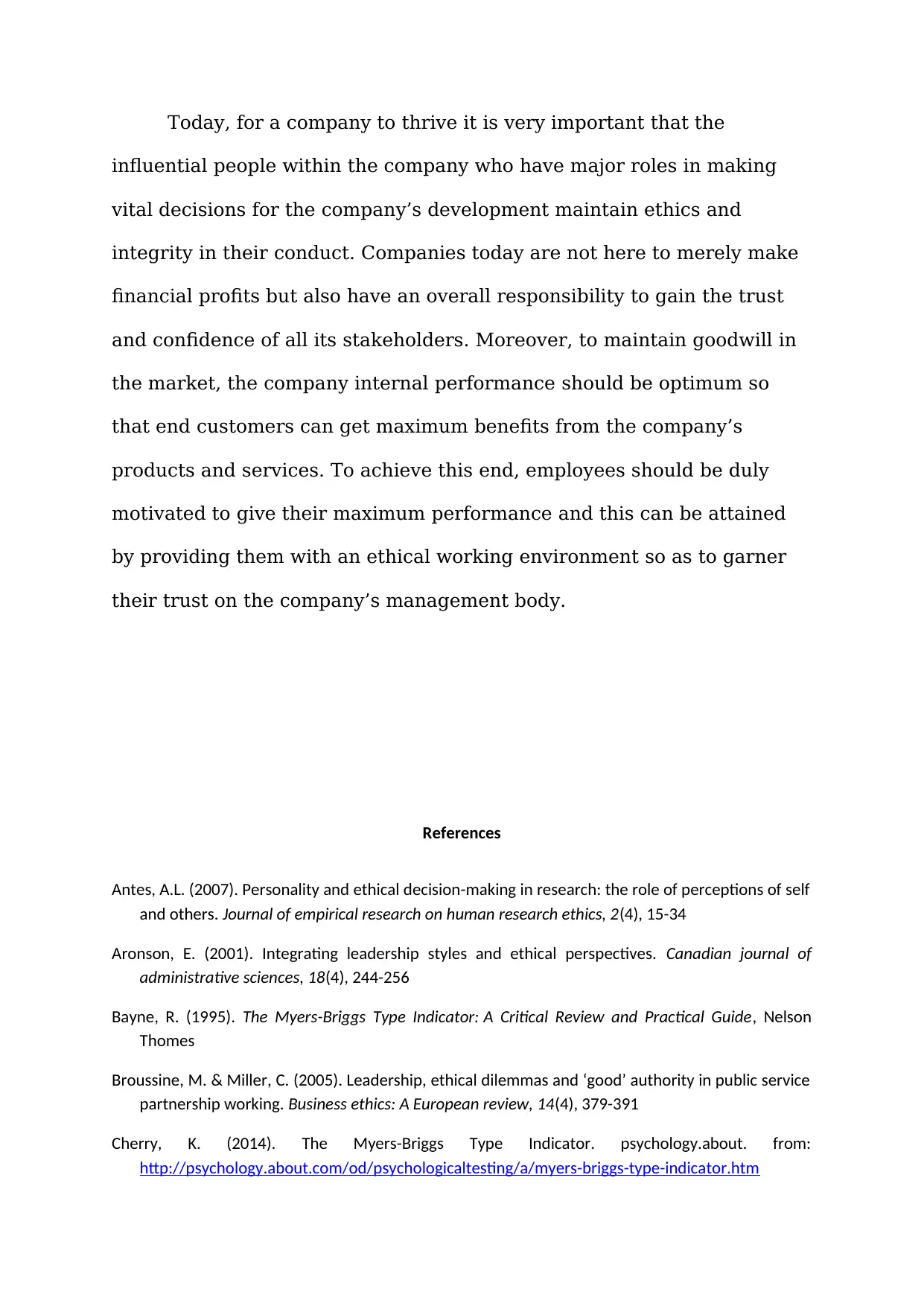
Today, for a company to thrive it is very important that the
influential people within the company who have major roles in making
vital decisions for the company’s development maintain ethics and
integrity in their conduct. Companies today are not here to merely make
financial profits but also have an overall responsibility to gain the trust
and confidence of all its stakeholders. Moreover, to maintain goodwill in
the market, the company internal performance should be optimum so
that end customers can get maximum benefits from the company’s
products and services. To achieve this end, employees should be duly
motivated to give their maximum performance and this can be attained
by providing them with an ethical working environment so as to garner
their trust on the company’s management body.
References
Antes, A.L. (2007). Personality and ethical decision-making in research: the role of perceptions of self
and others. Journal of empirical research on human research ethics, 2(4), 15-34
Aronson, E. (2001). Integrating leadership styles and ethical perspectives. Canadian journal of
administrative sciences, 18(4), 244-256
Bayne, R. (1995). The Myers-Briggs Type Indicator: A Critical Review and Practical Guide, Nelson
Thomes
Broussine, M. & Miller, C. (2005). Leadership, ethical dilemmas and ‘good’ authority in public service
partnership working. Business ethics: A European review, 14(4), 379-391
Cherry, K. (2014). The Myers-Briggs Type Indicator. psychology.about. from:
http://psychology.about.com/od/psychologicaltesting/a/myers-briggs-type-indicator.htm
influential people within the company who have major roles in making
vital decisions for the company’s development maintain ethics and
integrity in their conduct. Companies today are not here to merely make
financial profits but also have an overall responsibility to gain the trust
and confidence of all its stakeholders. Moreover, to maintain goodwill in
the market, the company internal performance should be optimum so
that end customers can get maximum benefits from the company’s
products and services. To achieve this end, employees should be duly
motivated to give their maximum performance and this can be attained
by providing them with an ethical working environment so as to garner
their trust on the company’s management body.
References
Antes, A.L. (2007). Personality and ethical decision-making in research: the role of perceptions of self
and others. Journal of empirical research on human research ethics, 2(4), 15-34
Aronson, E. (2001). Integrating leadership styles and ethical perspectives. Canadian journal of
administrative sciences, 18(4), 244-256
Bayne, R. (1995). The Myers-Briggs Type Indicator: A Critical Review and Practical Guide, Nelson
Thomes
Broussine, M. & Miller, C. (2005). Leadership, ethical dilemmas and ‘good’ authority in public service
partnership working. Business ethics: A European review, 14(4), 379-391
Cherry, K. (2014). The Myers-Briggs Type Indicator. psychology.about. from:
http://psychology.about.com/od/psychologicaltesting/a/myers-briggs-type-indicator.htm
⊘ This is a preview!⊘
Do you want full access?
Subscribe today to unlock all pages.

Trusted by 1+ million students worldwide
1 out of 14
Related Documents
Your All-in-One AI-Powered Toolkit for Academic Success.
+13062052269
info@desklib.com
Available 24*7 on WhatsApp / Email
![[object Object]](/_next/static/media/star-bottom.7253800d.svg)
Unlock your academic potential
Copyright © 2020–2025 A2Z Services. All Rights Reserved. Developed and managed by ZUCOL.





